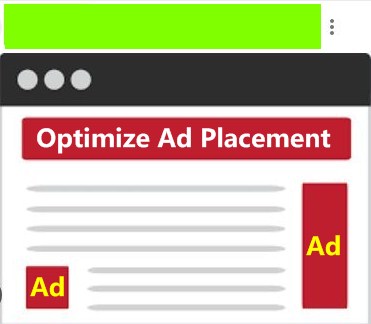Optimize Ad Placement in Google AdSense – Optimizing ad placement is a critical factor in increasing your Click-Through Rate (CTR) in Google AdSense. Here are some detailed tips on how to effectively optimize ad placement:

- Above the Fold Placement:
- Place some of your ad units above the fold, which refers to the portion of the webpage that is visible without scrolling. Ads in this area tend to get more attention because users see them immediately.
- In-Content Ads:
- Insert ad units within your content, preferably near the beginning or middle of articles. These ads can blend in naturally with your content and receive more clicks.
- Near High-Quality Content:
- Position ads near your high-quality and engaging content. Users are more likely to engage with ads when they are already interested in the content.
- Sidebar or Widget Areas:
- Utilize the sidebar or widget areas for ad placement. These sections are often visible and can be a good spot for ads without disrupting the main content.
- Header and Footer Banners:
- Place leaderboard or banner ads in the header or footer of your website. These are often visible without being too intrusive.
- Sticky Ads:
- Consider using sticky ads that stay fixed on the screen as the user scrolls down. These can be highly visible and effective.
- Interstitial and Pop-up Ads:
- Use interstitial or pop-up ads sparingly and only when they make sense for your content. Overusing these types of ads can annoy users.
- Responsive Design:
- Ensure your website has a responsive design that adapts to different screen sizes and devices. Responsive ads will fit seamlessly into your layout, improving user experience and CTR.
- Consider the F-Pattern:
- Research suggests that users tend to read web pages in an F-shaped pattern, focusing on the top and left-hand side. Place ads where users are more likely to look based on this reading pattern.
- Use Heatmaps and Analytics:
- Analyze heatmaps and user behavior using tools like Google Analytics to identify the areas of your website that receive the most attention. This information can guide your ad placement decisions.
- Test Multiple Placements:
- Implement A/B testing with different ad placements to see which ones perform better. Google AdSense offers tools for testing and optimizing ad positions.
- Mobile Optimization:
- Pay special attention to ad placement on mobile devices. Ensure that ads are responsive and well-placed for mobile users, as they make up a significant portion of internet traffic.
- Avoid Ad Blindness:
- Be mindful of “ad blindness,” where users become accustomed to ad placement and start ignoring them. Occasionally change ad positions to keep users engaged.
- Complement Content:
- Ensure that the ads you place are relevant to the content on the page. Users are more likely to click on ads that are related to what they are reading.
- Regularly Monitor Performance:
- Continuously monitor your AdSense performance reports to track which ad placements are generating the highest CTR and revenue. Make adjustments accordingly.
Note: Please, remember that what works best for ad placement can vary depending on your website’s layout, content, and audience. Therefore, it’s essential to experiment, analyze data, and fine-tune your ad placement strategy over time to maximize your CTR in Google AdSense.
![]()